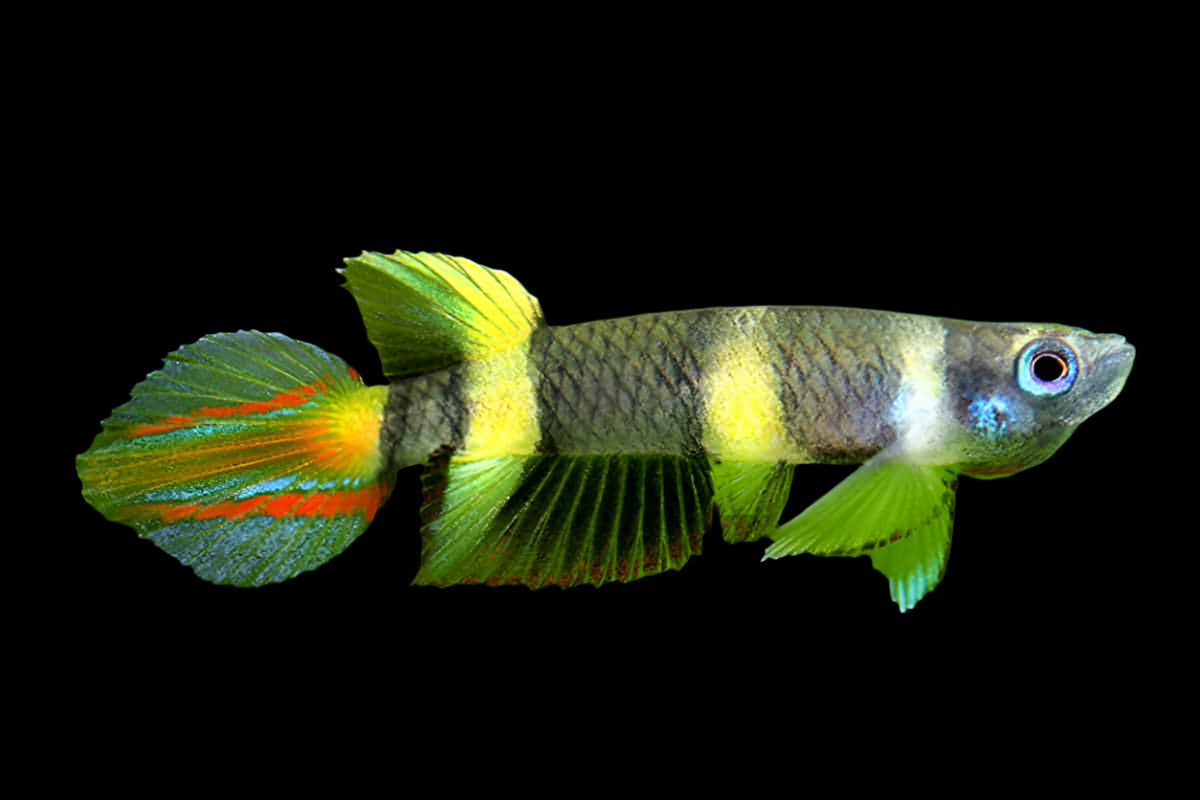Description
Clown Killifish – A Playful Splash of Color for Your Aquarium
(Epiplatys annulatus)
The Clown Killifish (Epiplatys annulatus) is a small yet striking species that brings vibrant color and dynamic behavior to your freshwater aquarium. With their bright orange, yellow, and blue markings, these killifish are a true visual treat. Known for their energetic and lively swimming style, they add a playful element to any tank, making them perfect for both beginner and experienced aquarists.
Key Features:
-
Vibrant Coloration: The Clown Killifish is a colorful masterpiece, featuring brilliant hues of orange, yellow, and blue across its body. These striking colors, combined with its sleek, elongated body, make this fish a true showstopper.
-
Energetic & Active: These fish are highly active and display fascinating behaviors, darting across the tank and leaping in playful bursts. They spend most of their time in the middle to upper levels of the aquarium, providing constant motion and excitement.
-
Small & Peaceful: Growing to only about 1.5 inches, Clown Killifish are ideal for small tanks or nano aquascapes. They are peaceful and non-aggressive, making them an excellent choice for community setups with similarly sized, non-predatory fish.
-
Easy to Care For: Clown Killifish are relatively hardy and adaptable to a wide range of water conditions, making them a great option for aquarists of all skill levels. They do best in stable environments with plenty of swimming space and hiding spots.
Tank Compatibility:
-
Freshwater Aquariums
-
Peaceful community tanks
-
Tankmates: Ideal for small, peaceful fish such as tetras, rasboras, and small livebearers. Avoid larger or more aggressive species that may intimidate or harm them.
Care Requirements:
-
Temperature: 75°F–82°F
-
pH: 6.5–7.5
-
Soft to moderately hard water
-
Provide plenty of plants, rocks, and hiding places to help them feel secure and reduce stress.
-
Keep a secure lid on your tank—these fish are known for their jumping ability.
Feeding Tips:
-
Clown Killifish are omnivores and will thrive on a diet of high-quality flake foods, micro-pellets, and live or frozen foods like brine shrimp, daphnia, and bloodworms.
-
A varied diet will keep them healthy and vibrant, supporting their energetic lifestyle.
Why Choose the Clown Killifish?
The Clown Killifish (Epiplatys annulatus) is a beautiful, active species that adds life and energy to any aquarium. Its striking colors, playful behavior, and peaceful temperament make it a perfect addition to both nano tanks and larger community setups. If you're looking for a small fish with big personality, the Clown Killifish is sure to captivate and entertain!
Click & Collect
Livestock will only be bagged once you arrive, or if you contact us in advance to request it ready beforehand.
Local Delivery
Order anything from our in-store range and have it delivered right to you.
-
Minimum spend: £50
-
Delivery up to 10 miles: £10
-
Delivery up to 25 miles: £20
Distances are measured “as the crow flies”, not by road.
Once your order is placed, we’ll be in touch to arrange a suitable delivery date and time.
Please note, delivery may take a little longer as we often group orders together to build an efficient delivery run.
Important: If you’re ordering a large aquarium, please ensure someone is available to help unload the van on arrival.
Dry Goods Delivery
-
DX Express: 1 working day, same-day dispatch before noon 0-75kg
-
Express Pallet: 1–3 working days 75-500kg
If you'd like to add more items to an existing order that hasn't yet been dispatched, please place a Click & Collect order and leave a note asking us to combine the orders.
Please note: We currently only dispatch parcels Wednesday to Friday.
Pre-Order
Want the full details? Check out our Terms & Conditions.
Livestock Delivery
Thursday Delivery – £24
-
Dispatched Wednesday afternoon
-
Delivered Thursday before 1pm
-
Order by Wednesday 12 noon
-
Minimum spend: £50
Friday Delivery – £24
-
Dispatched Thursday afternoon
-
Delivered Friday before 1pm
-
Order by Thursday 12 noon
-
Minimum spend: £50
Saturday Delivery – £29
-
Dispatched Friday afternoon
-
Delivered Saturday before 1pm
-
Order by Friday 12 noon
-
Minimum spend: £50
📦 Want to Add to an Existing Order?
No problem! Just place a Click & Collect order and leave a note asking us to link it with your original one (as long as it hasn’t been dispatched yet).
🛒 Dry Goods Now Included!
You can now include dry goods in your livestock delivery – perfect for topping up supplies in one go.
❄️ Please note: We can’t send frozen food with livestock – please order frozen items separately.
⚠️ Delivery Exclusions
Unfortunately, we’re unable to deliver livestock to the following postcodes:
Scotland & Isles:
AB30–AB56, DD8–DD10, DG3–DG9, DG12–DG14, FK17–FK21, KA18–KA19, KA26–KA30, PA20–PA38, PA80, PH3–PH40
Cornwall Isles: TR21–TR25
All of the following postcodes are excluded:
BT, HS, IM, IV, JE, KW
Plus Channel Islands and Shetland Islands
Payment & Security
Your payment information is processed securely. We do not store credit card details nor have access to your credit card information.

